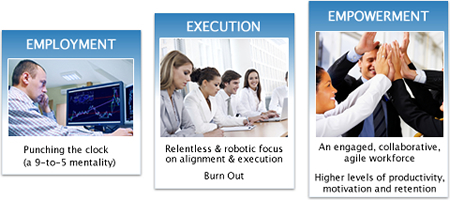Employee Empowerment and Retention Management
How to Make Your Organization Built to Last
Execution Is Not Enough
Organizations that have survived (or thrived) during the recent economic downturn have focused with laser-like intensity on the execution and performance of the business. But homing in on traditional business results has also escalated demands on the workforce. Staff cuts, tighter budgets and increasingly difficult workloads have created an environment in which employees are feeling overworked, undervalued and disengaged.
A focus on business results may have served organizations well in the short term, it won’t be enough to keep them ahead of the competition moving forward.
All employees – and top performers in particular – will need a deeper reason to stay when the economy recovers and it again becomes an "employee market". They will need to feel they are appreciated for their contributions, have the resources to do their jobs well, and have clearly defined opportunities to develop and advance within the organization.
In short, your employees must move away from simple employment and robotic execution to true empowerment.

What Is Employee Empowerment?
Empowered employees are engaged employees:
- They have the tools they need to be productive leaders and contribute to the success of the business
- They have the tools they need to learn and grow
- They have the tools they need to connect and collaborate with colleagues and others throughout the company
Why Does Having an Empowered Workforce Matter?
Empowerment can be viewed as a key performance indicator for the health and wellness of an organization's people strategy. Why?
- An empowered workforce is more engaged. Engaged employees drive higher customer satisfaction and boost the bottom line. The Gallup Organization reports that companies with higher-than-average employee engagement also had 27 percent higher profits, 50 percent higher sales and 50 percent higher customer loyalty.1
- An empowered workforce is higher performing and more productive. When people are empowered, they are more engaged – translating to higher levels of productivity and increased revenue. Research by the Forum for People Performance Management & Measurement found that organizations with engaged employees have customers who use their products more, which leads to higher customer satisfaction levels.2
- An empowered workforce experiences lower turnover. Engaged employees result in higher retention rates. Turnover costs can run anywhere from 25 percent to 250 percent of a position's annual salary, according to the American Management Association and other sources.
- An empowered workforce is more aligned with an organization's business goals. Empowered employees are in sync with the overall goals of the business. Alignment means they have the right skills, knowledge and expertise required to support current and future initiatives – contributing to greater talent readiness and succession planning.
Empowering employees also has taken on even more importance as companies face the challenge of motivating and retaining a younger generation of workers, for whom mobility is the name of the game. Even before the recession hit, fewer than half of all Gen Y workers planned to stay one to five years at their current jobs, and only 22 percent expected to stay six years or more.3
How Does Integrated Learning and Talent Management Fit In?
A learning and talent management strategy (and software solutions) can give your employees the right tools to be effective in their roles and to drive engagement and empowerment across the board.
- Give your employees the chance to develop new skills with Cornerstone Learning
- Provide career paths and opportunities for internal growth with Cornerstone Career Center
- Connect and drive collaboration with Cornerstone Connect
- Plan for the healthy future of the organization (and make sure the right people are in the right jobs) with Cornerstone Succession
- Give continuous and meaningful performance feedback (and align employee activity with goals) with Cornerstone Performance
Areas of talent management that include learning and development, performance management, succession planning and career management all can be used to promote a culture of empowerment.
Notes:
- Wagner, Rodd and James K. Harter, 2006, PhD, 12: The Elements of Great Managing, New York: Gallup Press.
- Towers Watson, 2010 Global Workforce Study.
- Robert Half International, 2007, What Millennial Workers Want: How to Attract and Retain Gen Y Employees.

 We are extremely pleased to announce that Dresser & Associates has joined Net@Work, one of the most respected Sage Software Partners in North America and an award-winning end-to-end technology solutions provider. You will see very little change relative to your Sage Software support, really just a name change.
We are extremely pleased to announce that Dresser & Associates has joined Net@Work, one of the most respected Sage Software Partners in North America and an award-winning end-to-end technology solutions provider. You will see very little change relative to your Sage Software support, really just a name change.









